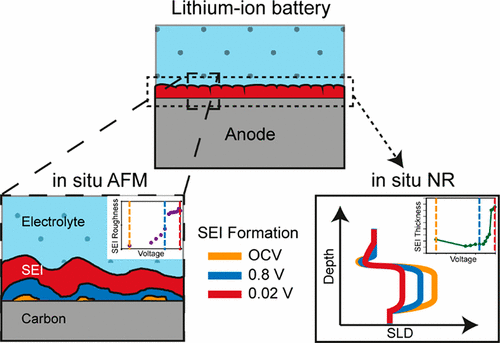当前位置:
X-MOL 学术
›
ACS Appl. Mater. Interfaces
›
论文详情
Our official English website, www.x-mol.net, welcomes your
feedback! (Note: you will need to create a separate account there.)
In Situ Studies of Solid Electrolyte Interphase (SEI) Formation on Crystalline Carbon Surfaces by Neutron Reflectometry and Atomic Force Microscopy
ACS Applied Materials & Interfaces ( IF 8.3 ) Pub Date : 2017-10-05 00:00:00 , DOI: 10.1021/acsami.7b09181 Miriam Steinhauer 1 , Michael Stich 2 , Mario Kurniawan 2 , Beatrix-Kamelia Seidlhofer 3 , Marcus Trapp 3 , Andreas Bund 2 , Norbert Wagner 1 , K. Andreas Friedrich 1, 4
ACS Applied Materials & Interfaces ( IF 8.3 ) Pub Date : 2017-10-05 00:00:00 , DOI: 10.1021/acsami.7b09181 Miriam Steinhauer 1 , Michael Stich 2 , Mario Kurniawan 2 , Beatrix-Kamelia Seidlhofer 3 , Marcus Trapp 3 , Andreas Bund 2 , Norbert Wagner 1 , K. Andreas Friedrich 1, 4
Affiliation

|
The solid electrolyte interphase (SEI) is a complex and fragile passivation layer with crucial importance for the functionality of lithium-ion batteries. Due to its fragility and reactivity, the use of in situ techniques is preferable for the determination of the SEI’s true structure and morphology during its formation. In this study, we use in situ neutron reflectometry (NR) and in situ atomic force microscopy (AFM) to investigate the SEI formation on a carbon surface. It was found that a lithium-rich adsorption layer is already present at the open circuit voltage on the carbon sample surface and that the first decomposition products start to deposit close to this potential. During the negative potential sweep, the growth of the SEI can be observed in detail by AFM and NR. This allows precise monitoring of the morphology evolution and the resulting heterogeneities of individual SEI features. NR measurements show a maximum SEI thickness of 192 Å at the lower cutoff potential (0.02 V vs Li/Li+), which slightly decreases during the positive potential scan. The scattering length density (SLD) obtained by NR provides additional information on the SEI’s chemical nature and structural evolution.
中文翻译:

用中子反射计和原子力显微镜原位研究晶体碳表面上固体电解质中间相(SEI)的形成
固体电解质中间相(SEI)是复杂且易碎的钝化层,对于锂离子电池的功能至关重要。由于其易碎性和反应性,在确定SEI形成过程中SEI的真实结构和形态时,最好使用原位技术。在这项研究中,我们使用原位中子反射计(NR)和原位原子力显微镜(AFM)来研究碳表面上的SEI形成。已经发现,在碳样品表面的开路电压下已经存在富含锂的吸附层,并且第一分解产物开始沉积在接近该电势的位置。在负电位扫描期间,可以通过AFM和NR详细观察SEI的增长。这样就可以精确监控各个SEI特征的形态演变以及由此产生的异质性。NR测量表明,在较低的截止电位下(0.02 V vs Li / Li,最大SEI厚度为192Å)+),在正电位扫描期间略有下降。NR获得的散射长度密度(SLD)提供了有关SEI的化学性质和结构演变的其他信息。
更新日期:2017-10-05
中文翻译:

用中子反射计和原子力显微镜原位研究晶体碳表面上固体电解质中间相(SEI)的形成
固体电解质中间相(SEI)是复杂且易碎的钝化层,对于锂离子电池的功能至关重要。由于其易碎性和反应性,在确定SEI形成过程中SEI的真实结构和形态时,最好使用原位技术。在这项研究中,我们使用原位中子反射计(NR)和原位原子力显微镜(AFM)来研究碳表面上的SEI形成。已经发现,在碳样品表面的开路电压下已经存在富含锂的吸附层,并且第一分解产物开始沉积在接近该电势的位置。在负电位扫描期间,可以通过AFM和NR详细观察SEI的增长。这样就可以精确监控各个SEI特征的形态演变以及由此产生的异质性。NR测量表明,在较低的截止电位下(0.02 V vs Li / Li,最大SEI厚度为192Å)+),在正电位扫描期间略有下降。NR获得的散射长度密度(SLD)提供了有关SEI的化学性质和结构演变的其他信息。


















































 京公网安备 11010802027423号
京公网安备 11010802027423号